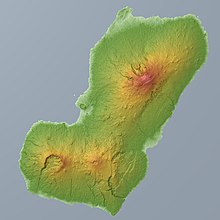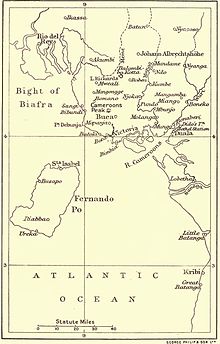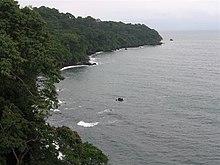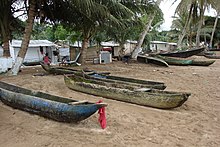Bioko
This article needs additional citations for verification. (June 2022) |

Bioko (
Etymology
Bioko's native name is Ëtulá a Ëri in the Bube language.[5] For nearly 500 years, the island was known as Fernando Po (Portuguese: Fernando Pó; Spanish: Fernando Poo), named for Portuguese navigator Fernão do Pó. Between 1973 and 1979 the island was named Macías Nguema Biyogo after the then president of Equatorial Guinea. The current name, Bioko, dates from 1979 and is in honour of politician Cristino Seriche Bioko.[6]: 68
Geography

Bioko has a total area of 2,017 km2 (779 sq mi). It is 70 km (43 mi) long from NNE to SSW and about 32 km (20 mi) across. The island is mostly covered by
Bioko lies on the African continental shelf, separated from the African mainland by 32 km (20 mi) of water with a depth of only 60 metres. During the Pleistocene epoch Bioko was connected to the African mainland. Bioko separated from Africa around 10,000 years ago, at the end of the Last Glacial Period.[7]
The
Fernando Po (with the spelling "Fernando Poo") is the setting for a Cold War standoff in Robert Shea and Robert Anton Wilson's Illuminatus Trilogy.[9]
Geology
The island is composed mostly of basalt, mostly alkali basalt and hawaiites, and to a lesser extent mugearites.[10]
Demographics
The island has a population of 335,048 inhabitants (2015 Census).
Languages
Spanish has been an official language since 1844 when Spain took control of the island. It is still the language of education and administration, related to the more than 100 years as a Spanish colony. 67.6% of Equatoguineans can speak Spanish, especially those living in the capital, Malabo, on Bioko.[11]
The Bube language, with about 50,000 speakers, and various dialects, is the original language of the inhabitants of Bioko. However, given the numerous ethnic groups and peoples who operated on Bioko, a creole language developed, known as Pichi. It is based on English grammar, from the period when the British operated bases for their forces. It also incorporates West African languages from Nigeria and Liberia, as well as Portuguese vocabulary, which forms a considerable part of the Krio language, which had developed in Sierra Leone. Workers came to Bioko from all of these areas in the 19th through much of the 20th century.
History
Unlike other islands in the area, Bioko had an indigenous African population. The island was inhabited in the middle of the first millennium BC by
In 1472, the Portuguese navigator Fernão do Pó was the first European to sight the island. He named it Formosa Flora ("beautiful flower"). In 1494 it was renamed Fernando Po in his honour after being claimed as a colony by the Portuguese. The Portuguese developed the island for sugarcane crops, and while considered poor quality, the refineries' output was such that Fernando Po sugar briefly dominated the trade centres in Europe.[citation needed]
In 1642, the Dutch East India Company established trade bases on the island without Portuguese consent. It temporarily centralized from there its slave trade in the Gulf of Guinea. The Portuguese appeared again on the island in 1648, replacing the Dutch Company with one of their own, also dedicated to slave trading and established in its neighbour island Corisco.[citation needed]
Parallel with this establishment, the Bubi clans began the slow process of establishing the core of a new kingdom on the island, especially after the activity of some local chiefs such as Molambo (approx. 1700–1760). During a period when enslavement was increasing in the region, local clans abandoned their coastal settlements and settled in the safer hinterland.[citation needed]
Under the 1778
Chief Molambo was succeeded by another local leader,

In March 1843,

In 1923–1930, the
During the Nigerian Civil War in the 20th century, relief agencies used the island as a base for flights into the secessionist Republic of Biafra.[citation needed]
Economy


Located on Punta Europa, west of Malabo, the Alba
Transport
A rectangular transport route links the four main cities: Malabo, Luba, Baney, and Riaba. The island's airport is Malabo International Airport.
Tourism
Tourist attractions include the colonial quarter in Malabo, and the southern part of the island, where visitors can hike to the
See also
- Annobón, an island
- Bight of Bonny also known as the Bight of Biafra
- Bioko drill
- Bioko Norte Province
- Bioko Sur Province
- Cameroon line
- Equatorial Guinea
- Emancipados, black people in Spanish Guinea assimilated to the Spaniards.
- Fernandino peoples
- Fernão do Pó, commander of the first European ship to land here.
- Gulf of Guinea
- Leopold Janikowski, Polish explorer who visited the island in 1883
- Kru people
- Tetteh Quarshie, a Ghanaian who introduced cocoa to his native country from the island.
- Luba Crater Scientific Reserve
- Movement for the Self-Determination of Bioko Island
- The English-lexicon Creole Pichi is spoken on Bioko
- Postage stamps and postal history of Fernando Po
References
- ^ "Equatorial Guinea - The World Factbook". cia.gov. 7 June 2018. Retrieved 24 June 2018.
- ISBN 0313321094.
- ISBN 9780786429417– via Google Books.
- ^ a b "Anuario Estadístico de Guinea Ecuatorial 2018" (PDF). Instituto Nacional de Estadisticas de Guinea Ecuatorial. Retrieved May 29, 2020.
- ^ "Playa de Arena Blanca". Atlas Obscura.
- ISBN 978-5-89216-029-2.
- PMID 34824795.
- ISBN 978-1-4214-0135-5, ("Fernand", p. 89).
- ^ "Excerpt from The Illuminatus! Trilogy". Penguin Random House Canada.
- ISSN 1674-9871.
- ^ Obiang convierte al portugués en tercer idioma oficial para entrar en la Comunidad lusófona de Naciones, Terra, 13 July 2007.
- ^ Goodman, Jordan (September 2007). "The Hell-Borne Traffic". geographical.co.uk. Archived from the original on 2012-01-07.
- ^ "British Empire: Africa: Fernando Po". britishempire.co.uk. Retrieved 28 April 2015.
- ^ Foreman, John (1906). The Philippine Islands: A Political, Geographical, Ethnographical, Social and Commercial History of the Philippine Archipelago. New York: Charles Scribner's Sons.
- S2CID 162982618.
- Room, Adrian (1994). African placenames. Jefferson, North Carolina (US): McFarland. ISBN 0-89950-943-6
- Sundiata, Ibrahim K. (1990). Equatorial Guinea: Colonialism, State Terror, and the Search for Stability. Boulder, Colorado (US): Westview Press. ISBN 0-8133-0429-6
- Janikowski, Leopold (1886). L'ile De Fernando-Poo, Son Etat Actuel Et Ses Habitants [The Island of Fernando Po, its current state and its inhabitants] (in French) (Bulletin De La Société De Géographie, Septième Série. - Tome Septième ed.).
- Janikowski, Leopold (1887). La Isla de Fernando Póo, su estado actual y sus habitantes [The Island of Fernando Po, its current state and its inhabitants] (in Spanish) (Boletín dela sociedad Geográfica de Madrid XXII ed.). pp. 67–77 and 201–211.
- Janikowski, Leopold (1936). W dżunglach Afryki. Wspomnienia z polskiej wyprawy afrykańskiej w latach 1882-90 [In the African Jungle. Memories of the Polish expedition to Africa in the years 1882-1890] (in Polish) (1936 ed.). Warsaw, Poland: Wydawnictwo Ligi Morskiej I Kolonjalnej; Skład Główny: Instytut Wydawn. Bibljoteka Polska S. A. Archived from the original on April 9, 2015. Retrieved April 9, 2015.
External links
- The Drill Project
- Bioko Biodiversity Protection Program
- Gulf of Guinea Conservation Group Archived 2020-04-10 at the Wayback Machine
- Bubi history and culture from a Spanish missionary
- Virginia Morell: "Island ark", National Geographic Magazine August 2008; link

